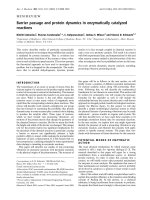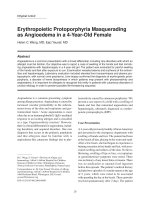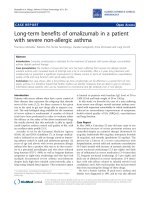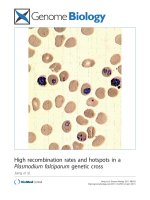Báo cáo y học: "Erythropoietic Protoporphyria Masquerading as Angioedema in a 4-Year-Old Female" docx
Bạn đang xem bản rút gọn của tài liệu. Xem và tải ngay bản đầy đủ của tài liệu tại đây (28.92 KB, 4 trang )
20
Angioedema is a common presenting symptom
among allergy practices. Angioedema is caused by
increased vascular permeability in the subcuta-
neous tissue of the skin and respiratory and gas-
trointestinal tracts.
1
Acute angioedema is most
often due to an immunoglobulin E (IgE)–mediated
response to an inciting allergen and is classified
as a type I hypersensitivity reaction.
1
However,
there is a broad differential for angioedema, includ-
ing hereditary and acquired disorders. One rare
diagnosis that occurs in the pediatric population
and that allergists must be familiar with is
angioedema-like cutaneous findings due to pho-
tosensitivity caused by cutaneous porphyrias.
2
We
present a case report of a child with a swelling of
hands and feet that mimicked angioedema and
hepatomegaly, ultimately diagnosed as erythro-
poietic protoporphyria (EPP).
Case Presentation
A 4-y
ear
-old previously healthy African American
g
ir
l pr
esented to the emer
g
ency department with
s
w
elling of hands and f
eet.
T
he patient had been
a
t the beac
h all da
y
,
playing in the water and sand.
After a f
e
w hour
s,
she had be
gun to experience a
b
ur
ning sensa
tion in her hands and f
eet,
with asso-
cia
ted s
w
elling and r
edness of the skin. No hi
ves,
b
lister
ing
,
s
welling of lips or face, or respiratory
or g
astr
ointestinal symptoms w
er
e noted. There
w
as no histor
y of an
y insect bites or tr
auma. There
w
as no medica
tion or un
usual f
ood ingestion
bef
or
e this e
pisode
. The patient’s medical history
inc
luded tw
o e
pisodes of a similar na
ture at the age
of 2 y
ear
s,
w
hich were noted to be associated
with spending the da
y a
t the beac
h.
These episodes
r
esolv
ed spontaneousl
y after 2 days. The patient
Original Article
Erythropoietic Protoporphyria Masquerading
as Angioedema in a 4-Year-Old Female
Helen C. Wang, MD; Ejaz Yousef, MD
Abstract
Angioedema is a common presentation with a broad differential, including rare disorders with which an
allergist must be familiar. Our objective was to report a case of swelling of the hands and feet mimick-
ing angioedema with hepatomegaly in a 4-year-old girl. The patient was evaluated for painful swelling
of the hands and feet after exposure to sun. Examination revealed edema and erythema of the extrem-
ities and hepatomegaly. Laboratory evaluation included elevated liver transaminases and plasma pro-
toporphyrin, with normal urine porphyrins. Liver biopsy confirmed the diagnosis of erythropoietic proto-
porphyria, a disorder of heme biosynthesis in which patients may present with photosensitivity and
angioedema. It is important for allergists to recognize this entity in patients with cutaneous disorders of
unclear etiology in order to prevent possible life-threatening sequelae.
H.C.
W
ang
,
E.
Y
ousef—Division of Allergy and
Imm
unology, Alfred I. duPont Hospital for Children,
Nemours Children’s Clinic, Wilmington, Delaware;
T
homas J
ef
f
er
son University, Philadelphia, Pennsylvania
Cor
r
espondence to:
Dr
. Ejaz
Yousef, Division of Allergy
and Imm
unology, Alfred I. duPont Hospital for Children,
1600 Roc
kland Road
,
W
ilmington,
DE; E-mail:
e
y
ousef@nemour
s.or
g
DOI 10.2310/7480.2006.00003
Erythropoietic Protoporphyria Masquerading as Angioedema — Wang and Yousef 21
also had a history of hives with amoxicillin use as
an infant; otherwise, there was no history of recur-
rent urticaria. Family history was significant for
allergic rhinitis in the mother, asthma in her half-
brother, and atopic dermatitis in her half-sister.
There was no reported family history of recurrent
swelling of the skin, chronic hives, or childhood
or unexplained deaths.
Examination revealed a well-nourished well-
developed female in no apparent distress. Vital
signs were stable, without fever, tachypnea, or
tachycardia. Weight and height were both in the
25th percentile for her age. Of note, an examina-
tion of her extremities revealed erythema, edema,
and tenderness on palpation of the hands and feet.
Her skin was hyperkeratotic and hyperpigmented
on the dorsa of her hands. No excoriations, denuded
areas, petechiae, or purpura were noted. Exami-
nations for Darier’s and Nikolsky’s signs were
negative. There was no evidence of der-
matographism. On abdominal examination, the
patient was noted to have a palpable nontender liver
edge approximately 4 to 5 cm below the right
costal margin. Sclerae were anicteric, and no jaun-
dice was noted. No splenomegaly was noted.
Laboratory evaluation included a complete
blood count and assessments of serum electrolytes,
blood urea nitrogen, creatinine, and glucose, the
results of which were normal. Other tests that
were performed and their results are as follows:
erythrocyte sedimentation rate (ESR), 22 mm/h
(0–13 mm/h); alanine transaminase, 301 U/L
(30–65 U/L); aspartate transpeptidase (AST),
182 U/L (15–37 U/L); and
␥-glutamyltransferase,
444 U/L (5–55 U/L). Total protein, bilirubin, albu-
min, antinuclear antibody (ANA), C4, and the
viral hepatitis panel were within normal limits.
Abdominal ultrasonography revealed a mildly
enlarged liver of normal echogenicity and without
evidence of cholelithiasis.
During the hospital course, the patient received
intravenous morphine sulfate and oral diphenhy-
dramine (12.5 mg, as needed) for pain and itchi-
ness.
T
he edema,
er
ythema,
and pain of the hands
and f
eet r
esolv
ed within 48 hour
s,
without any
scar
r
ing
.
T
he aller
g
y ser
vice was consulted to assist in
the e
v
alua
tion of the cutaneous f
indings. The ini-
tial differential diagnosis included acute allergic
angioedema, hereditary or acquired angioedema
from C1 inhibitor deficiency, idiopathic
angioedema, contact dermatitis, viral or bacterial
infection with skin manifestations, autoimmune
inflammatory disorders, malignancy, and metabolic
disorders (including cutaneous porphyrias).
1
The work-up included immediate-hypersensitiv-
ity skin testing with indoor and outdoor aeroal-
lergens to evaluate for an IgE-mediated trigger for
the pruritic dermatitis. This was performed with
the prick method, and the result was negative with
a positive histamine control. With a normal C4 level
during an acute episode, hereditary or acquired
angioedema from C1 inhibitor deficiency was
unlikely but was not fully ruled out. Autoimmune
disorders were less likely because the ANA level
was normal and the ESR was elevated only mildly,
but an assessment of extractable nuclear antigens
was not done. The normal complete blood count
lessened the likelihood that the skin findings were
from a viral or bacterial source or from a malig-
nancy such as leukemia. As the erythema and
edema were of acute onset and resolved within 48
hours, contact dermatitis was less likely to have
been the cause. The liver transaminases were per-
sistently elevated, and viral hepatitis testing results
were negative, which prompted further testing for
metabolic disorders, including urine and plasma
porphyrin analysis and liver biopsy. The patient did
have a significantly elevated protoporphyrin level
in the plasma (1,970
g/mL [0.4–4.8 g/mL]), and
examination of the liver biopsy specimen con-
firmed the diagnosis of EPP; there was an accu-
mulation of dark brown pigment displaying pathog-
nomonic Maltese-cross figures on birefringence,
with associated nodular fibrosis.
3
No genetic test-
ing has been performed to date.
The patient was started on beta carotene,
cholestyramine, ursodiol, vitamin E, and sun-
screen (sun protective factor [SPF] 50). The patient
has been on this treatment for the last 10 months,
and her liver function has been stabilized; however,
she has had inter
mittent e
pisodes of er
ythema and
itc
hiness of the skin on sun-e
xposed ar
eas suc
h as
her f
ace and e
xtr
emities,
e
ven with sunscreen use.
T
he pr
ur
itus has been par
tially alleviated with the
administr
a
tion of h
ydr
oxyzine. The patient’s father,
22 Allergy, Asthma, and Clinical Immunology / Volume 2, Number 1, Spring 2006
w
ho is asymptomatic, was subsequently found to
have elevated liver transaminases; however, he
has refused further evaluation through liver biopsy.
Discussion
EPP is a rare disorder of heme biosynthesis char-
acterized by early-childhood onset of acute pho-
tosensitivity of sun-exposed skin.
4,5
It is an auto-
somal dominant disorder with incomplete
penetrance.
6
Its prevalence in the general popu-
lation is 10 to 20 per 100,000, without any eth-
nic or gender predominance.
3
EPP is caused by
a def
iciency of ferrochelatase, the final enzyme
in heme synthesis,
which leads to an accumula-
tion of pr
otoporphyrin in various tissues, includ-
ing the skin and liver.
5
The release of protopor-
phyrin from erythrocytes is increased if the
erythrocytes are exposed to light. The cutaneous
symptoms are a consequence of protoporphyrin-
sensitized photodamage of endothelial cells as
well as initiating inflammatory pathways. Free
oxygen radicals are released from the light-
excited protoporphyrins, which leads to peroxi-
dation of lipids and cross-linking of membrane
proteins, which causes hemolysis of erythro-
cytes.
2
Protoporphyrin also induces the release of
mast-cell mediators such as histamine,
prostaglandin D, leukotrienes, and platelet-
activating factor.
1
Complement activation with the
generation of anaphylatoxins also plays a role in
the phototoxicity.
2
Polymorphonuclear cell
chemotaxis also increases to the affected area after
light e
xposur
e.
2
T
ypicall
y, EPP presents in childhood; the
af
f
ected child cries and complains of burning of
the skin on the f
ace and hands within min
utes
of sun e
xposur
e. Delayed effects that occur sev-
er
al hour
s later include swelling or erythema of
the af
f
ected area.
6
P
etec
hiae and purpura may
also occur; ho
wever, blisters or vesicles are
uncommon. P
atients may eventually develop a
w
axy cobblestone-like induration of the affected
ar
ea, frequently on the knuckles and fingers.
2
Major pr
esenting symptoms and signs include
b
urning (97%), edema (94%), itching (88%),
er
ythema (69%), and scarring of the skin (19%).
7
P
atients with EPP can develop liver disease
ranging from stable liver transaminase elevation
to acute hepatic failure requiring liver trans-
plantation. Less than 10% of patients with EPP
will develop severe liver disease.
3
Hyperpig-
mented cholelithiasis from hemolysis also may
present in young children.
3
Mild anemia is also
a common finding.
Diagnosis of EPP is based on elevated plasma,
erythrocyte, or fecal concentrations of protopor-
phyrins with normal urinary porphyrins due to
poor water solubility.
8
A liver biopsy specimen may
reveal an accumulation of deposits with peripor-
tal fibrosis.
5
Molecular analysis of the fer-
rochelatase mutation reveals missense, deletion,
and nonsense mutations, leading to functional
deficiency of ferrochelatase.
8
The gene has been
mapped to chromosome 18q22.
2
Treatment includes avoidance of sunlight and
the use of topical sunscreen agents with an SPF
of > 30 and ideally containing reflective compo-
nents such as zinc or titanium oxide.
3
Oral admin-
istration of beta carotene has been used as well,
at a dose of 120 to 180 mg daily to achieve a
serum beta carotene level of 600 to 800
g/dL.
8
Beneficial effects are usually seen 1 to 3 months
after the initiation of therapy.
8
The mechanism of
action may be from the reducing of activated free
oxygen radicals.
2
Cholestyramine (5 g, three times
daily) has also been used to decrease porphyrin lev-
els.
5
Vitamin E and pyridoxine have also been
used, with limited success.
3,5
Transfusions of red
blood cells and intravenous heme have been help-
ful in refractory cases.
3,5
At this time, ferrochelatase
r
eplacement is unavailable.
2
T
he prognosis in gen-
er
al is good for most patients with EPP in the
a
bsence of liver failure.
3
Conclusion
Although er
ythropoietic protoporphyria is rare
disor
der, it may initially present in patients in the
pedia
tric age group. It may be important for aller-
g
ists to recognize this entity at an early stage,
especiall
y in patients with cutaneous disorders
of unc
lear etiology, to prevent possible life-
thr
eatening complications.
Erythropoietic Protoporphyria Masquerading as Angioedema — Wang and Yousef 23
References
1. Kaplan AP. Urticaria and angioedema. In:Adkinson
NF, Yunginger JW, Busse WW, et al, editors.
Middleton’s allergy principles & practice. 6th ed.
Philadelphia: Mosby, Inc.; 2003. p. 1537–47.
2. Lim HW. Pathogenesis of photosensitivity in the
cutaneous porphyrias. J Invest Dermatol
2005;124:xvi–xvii.
3. Chemmanur AT, Bonkovsky HL. Hepatic por-
phyrias: diagnosis and management. Clin Liver
Dis 2004;8:807–38.
4. Magnus IA, Jarrett A, Prankerd TAJ, Rimington
C. Erythropoietic protoporphyria. A new por-
ph
yria syndrome with solar urticaria due to pro-
toporphyrinaemia. Lancet 1961;2:448–51.
5. Porphyrias. In: Habif TP, editor. Clinical der-
matology. 4th ed. Philadelphia: Mosby, Inc.; 2004.
p. 680.
6. Dombeck TA, Satonik RC. The porphyrias.
Emerg Med Clin North Am 2005;23:885–99.
7. DeLeo VA, Poh-Fitzpatrick M, Matthews-Roth
M, Harber LC. Erythropoietic protoporphyria.
10 years experience. Am J Med 1976;60:8–22.
8. Sassa S. The porphyrias. In: Behrman RE,
Kliegman RM, Jenson HB, editors. Nelson’s text-
book of pediatrics. 17th ed. Philadelphia: Elsevier;
2004. p. 495–504.









